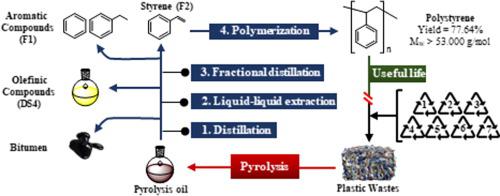Waste Management ( IF 7.1 ) Pub Date : 2020-09-03 , DOI: 10.1016/j.wasman.2020.08.035 Juan Baena-González 1 , Arantzazu Santamaria-Echart 2 , Juan Luis Aguirre 1 , Sergio González 1

|
As an alternative to conventional plastic-waste treatments, herein, we report a pyrolytic plastic-recovery process in which diverse compounds and materials are recovered from the pyrolysis oil obtained from the plastic waste. Distillation of the pyrolysis oil led to a bitumen and a distilled fraction. The composition of the bitumen, as determined by saturate, aromatic, resin, and asphaltene (S.A.R.A.) analysis and corroborated by Fourier-transform infrared (FTIR) spectroscopy, was found to principally contain aromatics (55.05 wt%) and saturates (33.41 wt%), and has great potential as a modifier for bitumen mixtures by decreasing the viscosities or softening points of final products. The distilled fraction was characterised and compared to pyrolysis oil in terms of its physicochemical properties and composition. Analysis by gas-chromatography/mass-spectrometry (GC-MS) revealed high levels of aromatics, namely styrene, benzene, toluene, ethylbenzene, and α-methylstyrene, which are potentially recoverable base compounds for industrial use. With this in mind, the distillate was subjected to various processes, including aromatic extraction with sulfolane and subsequent fractional distillation to recover the principal compounds in the various GC-MS fractions. Fraction 1 was found to be rich in ethylbenzene and toluene, while fraction 2 contained 73.26 wt% styrene and was used to synthesise recycled polystyrene (PS), whose yield and molecular weight (Mw) were optimised by adjusting the initiator concentration, temperature, and time. The optimised recycled PS was characterised to provide a yield of 77.64% and a Mw higher than 53,000 g/mol; this recycled PS exhibited similar thermal properties to those of conventional PS prepared using petrochemical sources.
中文翻译:

塑料废料的化学回收:热解油中的沥青,溶剂和聚苯乙烯。
作为常规塑料废物处理的替代方法,本文报道了一种热解塑料回收工艺,其中从从塑料废物中获得的热解油中回收了各种化合物和材料。热解油的蒸馏产生沥青和蒸馏馏分。通过饱和,芳香族,树脂和沥青质(SARA)分析确定并通过傅立叶变换红外(FTIR)光谱证实,沥青的成分主要包含芳香族化合物(55.05 wt%)和饱和化合物(33.41 wt%) ),并有可能通过降低最终产品的粘度或软化点而作为沥青混合物的改性剂。对蒸馏馏分进行表征,并根据其理化性质和组成与热解油进行比较。气相色谱/质谱(GC-MS)分析显示,芳烃含量高,即苯乙烯,苯,甲苯,乙苯和α-甲基苯乙烯,它们是工业上可回收的基础化合物。考虑到这一点,对馏出液进行各种处理,包括用环丁砜进行芳烃萃取,然后分馏以回收各种GC-MS馏分中的主要化合物。发现馏分1富含乙苯和甲苯,而馏分2包含73.26 wt%的苯乙烯,用于合成回收的聚苯乙烯(PS),其收率和分子量(M 对馏出液进行各种处理,包括用环丁砜进行芳烃萃取,然后分馏以回收各种GC-MS馏分中的主要化合物。发现馏分1富含乙苯和甲苯,而馏分2包含73.26 wt%的苯乙烯,用于合成回收的聚苯乙烯(PS),其收率和分子量(M 对馏出液进行各种处理,包括用环丁砜进行芳烃萃取,然后分馏以回收各种GC-MS馏分中的主要化合物。发现馏分1富含乙苯和甲苯,而馏分2包含73.26 wt%的苯乙烯,用于合成回收的聚苯乙烯(PS),其收率和分子量(M通过调节引发剂浓度,温度和时间来优化w)。优化的回收PS的特征是提供77.64%的收率和M w高于53,000 g / mol。这种回收的PS表现出与使用石化资源制备的传统PS相似的热性能。











































 京公网安备 11010802027423号
京公网安备 11010802027423号